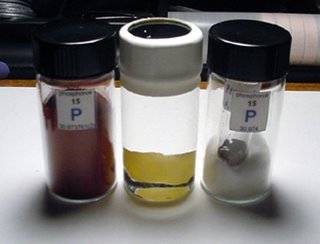Wednesday, June 14, 2006
Upcoming Regents Reviews Sessions...
First of all: Good luck on English part I and Math B tomorrow!
Our Chemistry Regents Review Sessions on Thursday AND Friday:
Room 136
Time: 3:30PM to 6:30PM (maybe we can order some "zuh" during/after the review!!)
Thanks for attending! Those of you not attending MUST download the files from the review sessions and do them at home. Do NOT go into the Regents exam without fully understanding the answers to those questions; I AM HERE TO HELP YOU!
If you DO know the answers for sure, you will do EXTREMELY WELL on the Regents exam.
We will cover chemical bonding and intermolecular attractions on Thursday.
I'm going ALL OUT, pedal to the metal, as the finish line approaches: I AM having a review session on Saturday, June 17. I will do an entire Regents (either Jan or Jun 2003) with y'all. I will have the session after prime beach time:
3:00PM to 6:00PM in Room 136.
Next week, I want to go over lab safety and lab techniques. Sometimes, people forget some of the lab error questions that appear on the Regents.
One more thing:
A question that came up in review about different ALLOTROPES of an element.
ALLOTROPES are different molecules of the same element. For example, diatomic oxygen is called "oxygen" but triatomic oxygen is "ozone".
Since O2 has a molar mass of 32. grams and O3 has a molar mass of 48. grams, these gases have different densities. Therefore they have different physical properties. Also, oxygen is odorless but ozone has a pungent (electric) scent.
There is even another, rarely encountered or detected allotrope of oxygen which is SOLID at pressure above 20 BILLION Pascals!:
Oxygen:
* dioxygen, O2 - colorless gas
* ozone, O3 - pale blue gas/deep blue liquid
* tetraoxygen, O4 - red solid
Do oxygen and ozone react chemically the same? EVEN THOUGH the molecules are made of atoms of the same element, the difference in BOND strength and length and STRUCTURE within these molecules CAUSES them to have DIFFERENT CHEMICAL PROPERTIES. Maybe not that different BUT STILL they do not always participate in the same reaction types in the same ways!
IN GENERAL, ALLOTROPES of an ELEMENT have DIFFERENT physical AND chemical properties!!!
Other examples of allotropes:
DIAMOND carbon vs. GRAPHITE carbon vs. BUCKYBALL carbon vs. carbon NANOTUBES!

Phosphorus:
* Red Phosphorus - polymeric solid
* White Phosphorus - crystalline solid
* Black Phosphorus - semiconductor, analogous to graphite
Sulphur:
* Plastic (amorphous) sulphur - polymeric solid
* Rhombic sulphur - large crystals composed of S8 molecules
* Monoclinic sulphur - fine needle-like crystals
* Molecular sulphur - sulphur tends to form ring molecules such as S7 and S12
Our Chemistry Regents Review Sessions on Thursday AND Friday:
Room 136
Time: 3:30PM to 6:30PM (maybe we can order some "zuh" during/after the review!!)
Thanks for attending! Those of you not attending MUST download the files from the review sessions and do them at home. Do NOT go into the Regents exam without fully understanding the answers to those questions; I AM HERE TO HELP YOU!
If you DO know the answers for sure, you will do EXTREMELY WELL on the Regents exam.
We will cover chemical bonding and intermolecular attractions on Thursday.
I'm going ALL OUT, pedal to the metal, as the finish line approaches: I AM having a review session on Saturday, June 17. I will do an entire Regents (either Jan or Jun 2003) with y'all. I will have the session after prime beach time:
3:00PM to 6:00PM in Room 136.
Next week, I want to go over lab safety and lab techniques. Sometimes, people forget some of the lab error questions that appear on the Regents.
One more thing:
A question that came up in review about different ALLOTROPES of an element.
ALLOTROPES are different molecules of the same element. For example, diatomic oxygen is called "oxygen" but triatomic oxygen is "ozone".
Since O2 has a molar mass of 32. grams and O3 has a molar mass of 48. grams, these gases have different densities. Therefore they have different physical properties. Also, oxygen is odorless but ozone has a pungent (electric) scent.
There is even another, rarely encountered or detected allotrope of oxygen which is SOLID at pressure above 20 BILLION Pascals!:
Oxygen:
* dioxygen, O2 - colorless gas
* ozone, O3 - pale blue gas/deep blue liquid
* tetraoxygen, O4 - red solid
Do oxygen and ozone react chemically the same? EVEN THOUGH the molecules are made of atoms of the same element, the difference in BOND strength and length and STRUCTURE within these molecules CAUSES them to have DIFFERENT CHEMICAL PROPERTIES. Maybe not that different BUT STILL they do not always participate in the same reaction types in the same ways!
IN GENERAL, ALLOTROPES of an ELEMENT have DIFFERENT physical AND chemical properties!!!
Other examples of allotropes:
DIAMOND carbon vs. GRAPHITE carbon vs. BUCKYBALL carbon vs. carbon NANOTUBES!

Phosphorus:
* Red Phosphorus - polymeric solid
* White Phosphorus - crystalline solid
* Black Phosphorus - semiconductor, analogous to graphite
Sulphur:
* Plastic (amorphous) sulphur - polymeric solid
* Rhombic sulphur - large crystals composed of S8 molecules
* Monoclinic sulphur - fine needle-like crystals
* Molecular sulphur - sulphur tends to form ring molecules such as S7 and S12